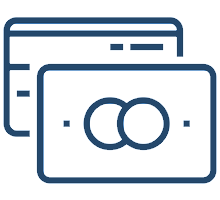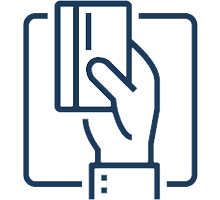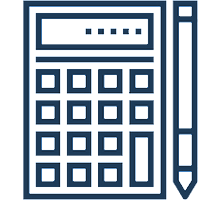An IVA may not be suitable for all circumstances.
Fees apply.
Monthly payments calculated on affordability.
Entering into an IVA will affect your credit rating. Certain debts cannot be included in an IVA such as hire purchase, student loans, secured debts, full list below. An IVA is a formal debt solution that can be used to help manage unaffordable debts. An IVA is a legally binding agreement between you and your creditors, where you agree to repay what you can afford within a fixed period, usually 5 to 6 years.*
To find out more about managing your money and getting free advice, visit Money Helper, an independent service set up to help people manage their money.
Debt Consolidation Loan Alternatives
Consolidating Debts With An IVA – This is a formal agreement where you agree to repay what you can afford within a fixed period, usually 5 to 6 years. The rest of the debt is written off.
Debt Management Plan – Informal / flexible plan where you can increase or decrease payments to your creditors dependent upon your circumstances.
Debt Relief Order – The duration of the DRO is usually 12 months and you do not need to make any payments.
Bankruptcy – In most cases you are discharged from bankruptcy after 12 months. Your creditors can no longer pursue you in relation to the balances outstanding and your debts are written off.
Debt Consolidation Loans. How They Work
Debt consolidation loans combine your debts into one single loan. There may be risks and extra costs. Get impartial advice before going ahead. This solution involves taking out new credit to pay off your debts.
Our 3 Step Process
Click “Get Started” above and answer the questions
Speak to an IVA expert to find out if you qualify for an IVA.
If you qualify & want to proceed, we can help you with your IVA proposal.

Our 3 Step Process
Click “Get Started” above and answer the questions
Speak to an IVA expert to find out if you qualify for an IVA.
If you qualify & want to proceed, we can help you with your IVA proposal.
What is an IVA?
An IVA stands for an Individual Voluntary Arrangement, this is a legally binding agreement between you and your creditors, where you agree to repay what you can afford within a fixed period, usually 5 to 6 years.
An IVA stands for an Individual Voluntary Arrangement, this is a legally binding agreement between you and your creditors, where you agree to repay what you can afford within a fixed period, usually 5 to 6 years. An IVA is not a loan but is a way of making a single new contract with each of your unsecured creditors. Once your IVA is approved you will pay a single monthly payment into your IVA for a fixed period of time instead of having to pay your creditors directly.
Your personal circumstances will be considered (income/outgoings), and so will your total debt level. Creditors’ approval is required before an IVA can commence.
A licensed Insolvency Practitioner must act on your behalf and negotiate with your creditorsso you don’t have to. During the IVA, your creditors must freeze all interest and charges. If your IVA is approved by your creditors this will require a long and professional relationship which requires you to be transparent and honest, you are required to keep the Insolvency Practitioner updated with any changes.
What are the risks and benefits of an IVA?
Risks
- An IVA will affect your credit rating for 6 years.
- Your IVA will be shown on the Insolvency Register.
- You cannot take out further credit whilst you are in the IVA above £500.
- Only unsecured debts can be included in an IVA.
- Failure to maintain payments may lead to the IVA being terminated.
Benefits
- Creditors cannot apply interest and charges following approval.
- Stops creditors included in the IVA from taking any further action against you.
- The term of your IVA is a set period.
- Affordable monthly repayments.
- The remaining debt included in your IVA is written off at the end.
What Debts can be included in an IVA:
- Council Tax arrears
- Credit Cards
- Payday Loans
- Overdrafts
- Store Cards
- Catalogues
- Arrears on utility bills, e.g. Gas / Water / Electric bills
- Money owed to family and friends
- Personal Debts, e.g. money
- Unpaid personal VAT bills, Tax and National Insurance
- Unsecured personal loans
- Tax credit or benefit overpayments
- Other outstanding bills, for example solicitor’s costs, invoices for building work and vets bills
Debts that cannot be included in an IVA are:
- Child Maintenance
- Mortgages
- Student Loans
- TV License Arrears
- Hire purchase agreements
- Magistrates’ court fines
- Secured debts
- Maintenance arrears that have been ordered by a court
- Social fund loans
- TV licence arrears
Can joint debts be included in an IVA?
A joint debt is a debt in your name and someone else’s.
Joint debts can be included in an IVA, but:
- The other person still needs to make their payments.
- The other person is still liable to pay the whole amount of the joint debt.
It may be helpful for the other person to get seek independent help too.

Frequently asked questions
An IVA allows you to repay your creditors what you can afford within a specified time frame. If an IVA is approved creditors are legally obliged to write off any outstanding balances upon successful completion of your IVA.
To determine if you qualify for an IVA your income and expenditure is reviewed to see how much you can afford to repay. Your personal circumstances will be considered (income/outgoings), and so will your total debt level. If you meet the criteria then your IVA proposal to creditors will include the total amount to be repaid, the amount to be written off, and the end date for your IVA.
An IVA typically lasts between 5-6 years dependent upon your circumstances.
You do not have to make any payment unless creditors approve your IVA. If you choose to proceed and propose an IVA to your creditors as your chosen debt solution then there are fees involved which are included in your monthly payments, not in addition.
Typically, from the payments that you make into your IVA you can expect to pay the following:
Nominee’s Fee
This fee covers our professional costs and charges for arranging your IVA. This is usually around £1,900.
Supervisor’s Fee
This covers the administration work involved in running your IVA. This is usually based on a percentage of the money you pay back during the IVA and is around 15% of realisations.
Expenses
This includes insurance, a fee for registering your IVA on the Insolvency Register etc
Creditors usually agree the fee basis for your IVA when considering your IVA proposal. Full details of the fees proposed will be discussed with you when drafting your IVA proposal which will require your agreement.
An IVA will affect your credit rating for 6 years from the date of approval as you are not making your contractual payments. The IVA will show on your credit file and will be shown on the Insolvency Register.
If your IVA is approved your Insolvency Practitioner will communicate with your creditors. Your creditors are still required to send you statements in line with the Consumer Credit Act 1974, however once your IVA has been approved your creditors should no longer contact you in relation to payments as these are made from your IVA. It can take up to 3 months for creditors to update their records. Your Insolvency Practitioner will continue to communicate with creditors until this contact ceases.
Not every type of debt can be included in an IVA, examples of debts that can be included in an IVA are:
- Council Tax arrears
- Credit Cards
- Payday Loans
- Overdrafts
- Store Cards
- Catalogues
- Arrears on utility bills, e.g. Gas / Water / Electric bills
- Money owed to family and friends
- Personal Debts, e.g. money
- Unpaid personal VAT bills, Tax and National Insurance
- Unsecured personal loans
- Tax credit or benefit overpayments
- Other outstanding bills, for example solicitor’s costs, invoices for building work and vets bills
You cannot include your ‘secured’ debts in an IVA, and you should maintain payments towards these. Examples of debts that an IVA cannot cover are:
- Child Maintenance
- Mortgages
- Student Loans
- TV License Arrears
- Hire purchase agreements
- Magistrates’ court fines
- Maintenance arrears that have been ordered by a court
- Social fund loans
- TV licence arrears














